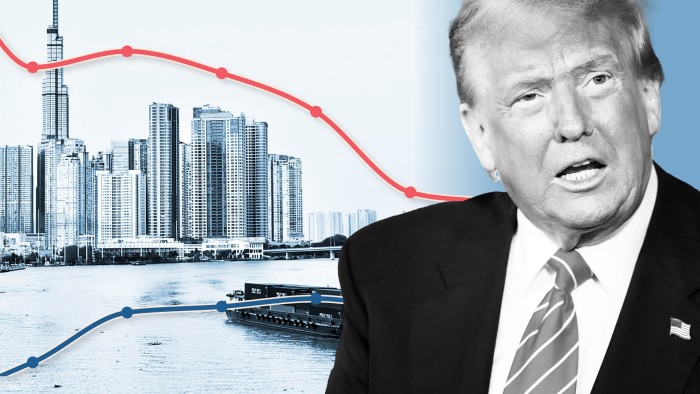Unlock the White House Watch newsletter for free
Your guide to what Trump’s second term means for Washington, business and the world
Donald Trump’s latest act of trade brinkmanship risks creating a “tariff wall” around the manufacturing hubs of south-east Asia, leading to higher prices and tough choices for US consumers and industry, analysts warn.
Ahead of Wednesday’s deadline to cut trade deals with Washington, the US president signalled a fresh round of tariffs on the south-east Asian countries that have become a conduit for Chinese manufacturers looking to escape US levies.
He threatened Cambodia, Indonesia, Laos, Malaysia and Thailand with duties ranging from 25 to 40 per cent in an apparent final bid to force them to the negotiating table ahead of a new August 1 deadline.
Last week, Trump announced that Vietnam — the biggest destination for “rerouted” Chinese goods — had accepted a 20 per cent tariff on its exports to the US, rising to 40 per cent for goods that had been “transshipped”.
The US administration expects its trade policies to raise more than $300bn in revenue by the end of the year, with Trump saying on Wednesday that “the big money will start coming in on August 1”.
Economists said that, while it was hard to predict at what level duties would finally settle, the outline of a new Asian tariff wall was beginning to take shape that would warp regional and global supply chains.
Alicia García Herrero, chief economist for Asia Pacific at investment bank Natixis, said there was still time for south-east Asian countries such as Cambodia, Malaysia and Thailand to negotiate a better deal with Washington.
She argued that Vietnam’s 20 per cent tariff deal did not necessarily have to become the benchmark for other south-east Asian countries that were less dependent on China for their manufacturing inputs, and less guilty of accepting rerouting goods to avoid US tariffs.
But whatever the final tariffs levels agreed, she added that they would force up prices for goods exported from south-east Asia, which remains a manufacturing hub for many consumer goods sold in the US.
“Manufacturing will get more expensive in Asia generally, but in principle the 20 per cent ‘tariff wall’ might be different across countries where inputs from China are smaller. I don’t think it has to be the same,” she said.
Mark Williams, chief Asia economist at consultancy Capital Economics, which tracks rerouting of Chinese goods through other Asian countries, agreed that there could still be a “fair degree of inconsistency” among tariff rates for countries and industries in the region.
However he added that Trump’s tariff wall would have regional supply chain impacts, including potentially slowing the shift of Chinese manufacturing into the 10 nations of the Association of Southeast Asian Nations regional grouping, which accelerated during Trump’s first term.
“A relatively high tariff on countries that could substitute for China in global manufacturing would probably slow the shift of firms out of China [because] there would be less urgency if the wedge between tariffs on China and other manufacturing economies was smaller,” Williams said.
But even if tariffs settled at a relatively high rate, they would fail to achieve the administration’s stated ambition of pulling manufacturing back into the US, Williams argued.
“The choice for consumers and firms in the US will be between paying more for a foreign-made product that now has an additional tariff, or going without. And in many sectors US production wouldn’t be competitive with imports, even if tariffs have to be paid,” he said.
Trump’s decision to slap punitive duties on countries that transshipped Chinese goods will also be a huge opportunity for the supply chain management industry, according to Alex Capri, senior lecturer at the National University of Singapore’s business school.
“The new Trump tariffs will require importers to have reliable traceability practices to spare them from these arbitrary ‘transshipment tariffs’. This will result in a burgeoning services sector around the necessary technologies and verification processes,” he added.
Data visualisation by Jonathan Vincent. Additional reporting by James Politi in Washington






